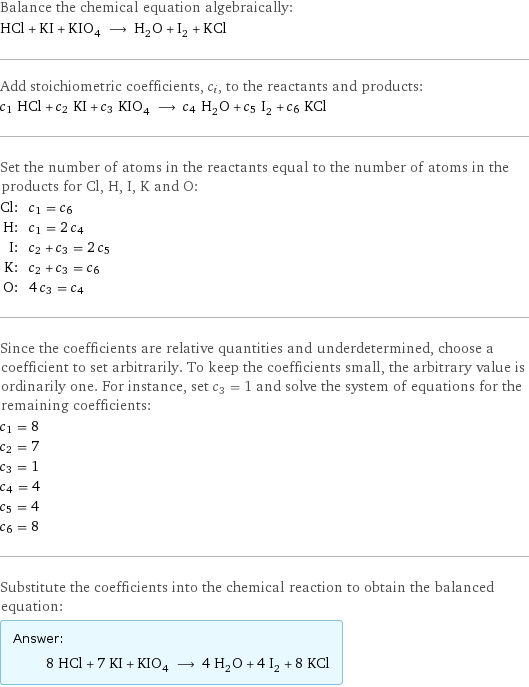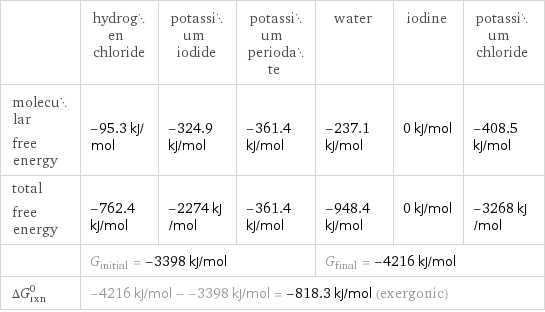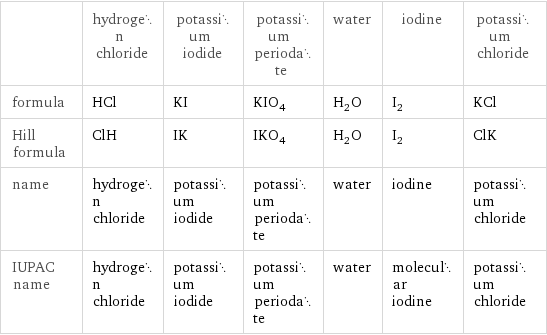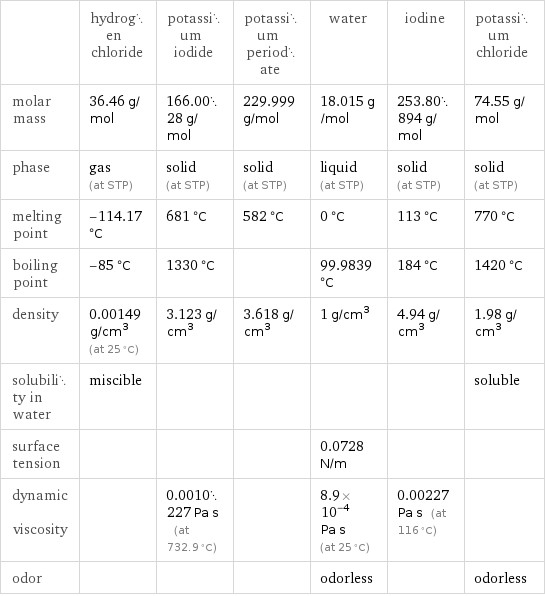Input interpretation

HCl (hydrogen chloride) + KI (potassium iodide) + KIO_4 (potassium periodate) ⟶ H_2O (water) + I_2 (iodine) + KCl (potassium chloride)
Balanced equation

Balance the chemical equation algebraically: HCl + KI + KIO_4 ⟶ H_2O + I_2 + KCl Add stoichiometric coefficients, c_i, to the reactants and products: c_1 HCl + c_2 KI + c_3 KIO_4 ⟶ c_4 H_2O + c_5 I_2 + c_6 KCl Set the number of atoms in the reactants equal to the number of atoms in the products for Cl, H, I, K and O: Cl: | c_1 = c_6 H: | c_1 = 2 c_4 I: | c_2 + c_3 = 2 c_5 K: | c_2 + c_3 = c_6 O: | 4 c_3 = c_4 Since the coefficients are relative quantities and underdetermined, choose a coefficient to set arbitrarily. To keep the coefficients small, the arbitrary value is ordinarily one. For instance, set c_3 = 1 and solve the system of equations for the remaining coefficients: c_1 = 8 c_2 = 7 c_3 = 1 c_4 = 4 c_5 = 4 c_6 = 8 Substitute the coefficients into the chemical reaction to obtain the balanced equation: Answer: | | 8 HCl + 7 KI + KIO_4 ⟶ 4 H_2O + 4 I_2 + 8 KCl
Structures

+ + ⟶ + +
Names

hydrogen chloride + potassium iodide + potassium periodate ⟶ water + iodine + potassium chloride
Reaction thermodynamics
Enthalpy

| hydrogen chloride | potassium iodide | potassium periodate | water | iodine | potassium chloride molecular enthalpy | -92.3 kJ/mol | -327.9 kJ/mol | -467.2 kJ/mol | -285.8 kJ/mol | 0 kJ/mol | -436.5 kJ/mol total enthalpy | -738.4 kJ/mol | -2295 kJ/mol | -467.2 kJ/mol | -1143 kJ/mol | 0 kJ/mol | -3492 kJ/mol | H_initial = -3501 kJ/mol | | | H_final = -4635 kJ/mol | | ΔH_rxn^0 | -4635 kJ/mol - -3501 kJ/mol = -1134 kJ/mol (exothermic) | | | | |
Gibbs free energy

| hydrogen chloride | potassium iodide | potassium periodate | water | iodine | potassium chloride molecular free energy | -95.3 kJ/mol | -324.9 kJ/mol | -361.4 kJ/mol | -237.1 kJ/mol | 0 kJ/mol | -408.5 kJ/mol total free energy | -762.4 kJ/mol | -2274 kJ/mol | -361.4 kJ/mol | -948.4 kJ/mol | 0 kJ/mol | -3268 kJ/mol | G_initial = -3398 kJ/mol | | | G_final = -4216 kJ/mol | | ΔG_rxn^0 | -4216 kJ/mol - -3398 kJ/mol = -818.3 kJ/mol (exergonic) | | | | |
Equilibrium constant
![Construct the equilibrium constant, K, expression for: HCl + KI + KIO_4 ⟶ H_2O + I_2 + KCl Plan: • Balance the chemical equation. • Determine the stoichiometric numbers. • Assemble the activity expression for each chemical species. • Use the activity expressions to build the equilibrium constant expression. Write the balanced chemical equation: 8 HCl + 7 KI + KIO_4 ⟶ 4 H_2O + 4 I_2 + 8 KCl Assign stoichiometric numbers, ν_i, using the stoichiometric coefficients, c_i, from the balanced chemical equation in the following manner: ν_i = -c_i for reactants and ν_i = c_i for products: chemical species | c_i | ν_i HCl | 8 | -8 KI | 7 | -7 KIO_4 | 1 | -1 H_2O | 4 | 4 I_2 | 4 | 4 KCl | 8 | 8 Assemble the activity expressions accounting for the state of matter and ν_i: chemical species | c_i | ν_i | activity expression HCl | 8 | -8 | ([HCl])^(-8) KI | 7 | -7 | ([KI])^(-7) KIO_4 | 1 | -1 | ([KIO4])^(-1) H_2O | 4 | 4 | ([H2O])^4 I_2 | 4 | 4 | ([I2])^4 KCl | 8 | 8 | ([KCl])^8 The equilibrium constant symbol in the concentration basis is: K_c Mulitply the activity expressions to arrive at the K_c expression: Answer: | | K_c = ([HCl])^(-8) ([KI])^(-7) ([KIO4])^(-1) ([H2O])^4 ([I2])^4 ([KCl])^8 = (([H2O])^4 ([I2])^4 ([KCl])^8)/(([HCl])^8 ([KI])^7 [KIO4])](../image_source/7e24c7633b39a409f783f1eb178f09ed.png)
Construct the equilibrium constant, K, expression for: HCl + KI + KIO_4 ⟶ H_2O + I_2 + KCl Plan: • Balance the chemical equation. • Determine the stoichiometric numbers. • Assemble the activity expression for each chemical species. • Use the activity expressions to build the equilibrium constant expression. Write the balanced chemical equation: 8 HCl + 7 KI + KIO_4 ⟶ 4 H_2O + 4 I_2 + 8 KCl Assign stoichiometric numbers, ν_i, using the stoichiometric coefficients, c_i, from the balanced chemical equation in the following manner: ν_i = -c_i for reactants and ν_i = c_i for products: chemical species | c_i | ν_i HCl | 8 | -8 KI | 7 | -7 KIO_4 | 1 | -1 H_2O | 4 | 4 I_2 | 4 | 4 KCl | 8 | 8 Assemble the activity expressions accounting for the state of matter and ν_i: chemical species | c_i | ν_i | activity expression HCl | 8 | -8 | ([HCl])^(-8) KI | 7 | -7 | ([KI])^(-7) KIO_4 | 1 | -1 | ([KIO4])^(-1) H_2O | 4 | 4 | ([H2O])^4 I_2 | 4 | 4 | ([I2])^4 KCl | 8 | 8 | ([KCl])^8 The equilibrium constant symbol in the concentration basis is: K_c Mulitply the activity expressions to arrive at the K_c expression: Answer: | | K_c = ([HCl])^(-8) ([KI])^(-7) ([KIO4])^(-1) ([H2O])^4 ([I2])^4 ([KCl])^8 = (([H2O])^4 ([I2])^4 ([KCl])^8)/(([HCl])^8 ([KI])^7 [KIO4])
Rate of reaction
![Construct the rate of reaction expression for: HCl + KI + KIO_4 ⟶ H_2O + I_2 + KCl Plan: • Balance the chemical equation. • Determine the stoichiometric numbers. • Assemble the rate term for each chemical species. • Write the rate of reaction expression. Write the balanced chemical equation: 8 HCl + 7 KI + KIO_4 ⟶ 4 H_2O + 4 I_2 + 8 KCl Assign stoichiometric numbers, ν_i, using the stoichiometric coefficients, c_i, from the balanced chemical equation in the following manner: ν_i = -c_i for reactants and ν_i = c_i for products: chemical species | c_i | ν_i HCl | 8 | -8 KI | 7 | -7 KIO_4 | 1 | -1 H_2O | 4 | 4 I_2 | 4 | 4 KCl | 8 | 8 The rate term for each chemical species, B_i, is 1/ν_i(Δ[B_i])/(Δt) where [B_i] is the amount concentration and t is time: chemical species | c_i | ν_i | rate term HCl | 8 | -8 | -1/8 (Δ[HCl])/(Δt) KI | 7 | -7 | -1/7 (Δ[KI])/(Δt) KIO_4 | 1 | -1 | -(Δ[KIO4])/(Δt) H_2O | 4 | 4 | 1/4 (Δ[H2O])/(Δt) I_2 | 4 | 4 | 1/4 (Δ[I2])/(Δt) KCl | 8 | 8 | 1/8 (Δ[KCl])/(Δt) (for infinitesimal rate of change, replace Δ with d) Set the rate terms equal to each other to arrive at the rate expression: Answer: | | rate = -1/8 (Δ[HCl])/(Δt) = -1/7 (Δ[KI])/(Δt) = -(Δ[KIO4])/(Δt) = 1/4 (Δ[H2O])/(Δt) = 1/4 (Δ[I2])/(Δt) = 1/8 (Δ[KCl])/(Δt) (assuming constant volume and no accumulation of intermediates or side products)](../image_source/5cba504c664830475fe5cc5fffe22ab7.png)
Construct the rate of reaction expression for: HCl + KI + KIO_4 ⟶ H_2O + I_2 + KCl Plan: • Balance the chemical equation. • Determine the stoichiometric numbers. • Assemble the rate term for each chemical species. • Write the rate of reaction expression. Write the balanced chemical equation: 8 HCl + 7 KI + KIO_4 ⟶ 4 H_2O + 4 I_2 + 8 KCl Assign stoichiometric numbers, ν_i, using the stoichiometric coefficients, c_i, from the balanced chemical equation in the following manner: ν_i = -c_i for reactants and ν_i = c_i for products: chemical species | c_i | ν_i HCl | 8 | -8 KI | 7 | -7 KIO_4 | 1 | -1 H_2O | 4 | 4 I_2 | 4 | 4 KCl | 8 | 8 The rate term for each chemical species, B_i, is 1/ν_i(Δ[B_i])/(Δt) where [B_i] is the amount concentration and t is time: chemical species | c_i | ν_i | rate term HCl | 8 | -8 | -1/8 (Δ[HCl])/(Δt) KI | 7 | -7 | -1/7 (Δ[KI])/(Δt) KIO_4 | 1 | -1 | -(Δ[KIO4])/(Δt) H_2O | 4 | 4 | 1/4 (Δ[H2O])/(Δt) I_2 | 4 | 4 | 1/4 (Δ[I2])/(Δt) KCl | 8 | 8 | 1/8 (Δ[KCl])/(Δt) (for infinitesimal rate of change, replace Δ with d) Set the rate terms equal to each other to arrive at the rate expression: Answer: | | rate = -1/8 (Δ[HCl])/(Δt) = -1/7 (Δ[KI])/(Δt) = -(Δ[KIO4])/(Δt) = 1/4 (Δ[H2O])/(Δt) = 1/4 (Δ[I2])/(Δt) = 1/8 (Δ[KCl])/(Δt) (assuming constant volume and no accumulation of intermediates or side products)
Chemical names and formulas

| hydrogen chloride | potassium iodide | potassium periodate | water | iodine | potassium chloride formula | HCl | KI | KIO_4 | H_2O | I_2 | KCl Hill formula | ClH | IK | IKO_4 | H_2O | I_2 | ClK name | hydrogen chloride | potassium iodide | potassium periodate | water | iodine | potassium chloride IUPAC name | hydrogen chloride | potassium iodide | potassium periodate | water | molecular iodine | potassium chloride
Substance properties

| hydrogen chloride | potassium iodide | potassium periodate | water | iodine | potassium chloride molar mass | 36.46 g/mol | 166.0028 g/mol | 229.999 g/mol | 18.015 g/mol | 253.80894 g/mol | 74.55 g/mol phase | gas (at STP) | solid (at STP) | solid (at STP) | liquid (at STP) | solid (at STP) | solid (at STP) melting point | -114.17 °C | 681 °C | 582 °C | 0 °C | 113 °C | 770 °C boiling point | -85 °C | 1330 °C | | 99.9839 °C | 184 °C | 1420 °C density | 0.00149 g/cm^3 (at 25 °C) | 3.123 g/cm^3 | 3.618 g/cm^3 | 1 g/cm^3 | 4.94 g/cm^3 | 1.98 g/cm^3 solubility in water | miscible | | | | | soluble surface tension | | | | 0.0728 N/m | | dynamic viscosity | | 0.0010227 Pa s (at 732.9 °C) | | 8.9×10^-4 Pa s (at 25 °C) | 0.00227 Pa s (at 116 °C) | odor | | | | odorless | | odorless
Units
